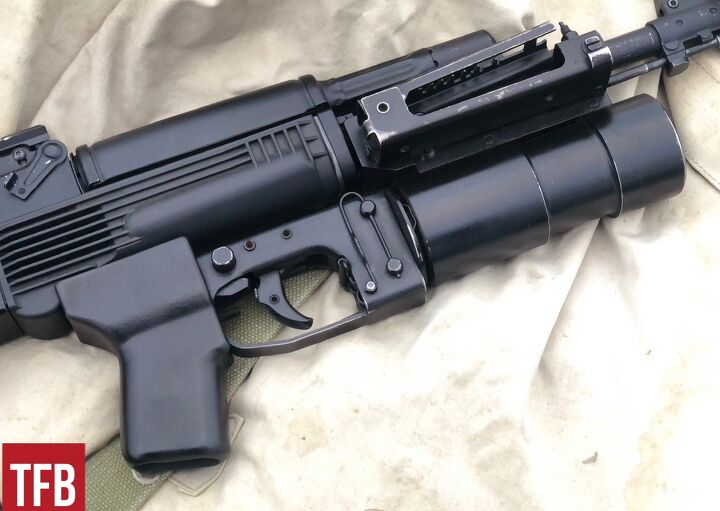The Story Of The Russian GP Series Of Grenade Launchers

In the jungles of Vietnam, US special forces started to deploy under-barrel grenade launchers with the philosophy of combining grenadier and rifleman “seamlessly” into one platform. Beginning development in 1964 with the GLAD project (Grenade Launcher Attachment Development), MACV-SOG (Military Assistance Command, Vietnam-Studies, and Observation Group) operators were finally slung in 1967 with the XM148 grenade launchers under their XM177 carbines, the progenitors of the Colt Commando, M4 series, and arguably, the AKS-74U “Krinkov.” Just a year later, the US was fielding to great effect full-size M16s with the pump open XM203, instantly recognizable by its distinct cheese grater ventilated heat shield over the rifle’s barrel. Soviet intelligence quickly took notice of this development cycle, likely long before the weapon ended up in the hands of US operators.

Nonetheless, developing under-barrel grenade launchers is easier said than done, especially for a weapon platform inherently less modular than the M16. The Soviets recorded the first proposal in 1963 and began experimenting with grenade launcher attachments in 1966 with the TKB-048, the first under-barrel grenade launcher of the socialist state, yielding unsatisfactory results.
The TKB-0121 followed in 1971-1972. After initial failures, the project came under the direction of V. N. Telesh, and subsequent Soviet grenade launchers to this day would be based on his ideas.
Nonetheless, it took nearly a decade for the Soviet arms bureau to accept a working model, the GP-25, Grenatamyot Podstvolny 25 – literally as grenade launcher under-barrel 25, adopted formally in 1978.
Once again, just over a decade later, the design was updated to the GP-30 by the Tula based Central Design Research Bureau of Sports and Hunting Arms TsKIB SOO. This time, the GP-30 had staying power just like its American counterpart, the XM203.
All iterations of the GP series require mounting to full-sized AKs, precluding the AK104/5, AKS74U, and the current shortened versions of the AK200 series. The system also has a safety lock only to allow fire once secured to the “grenade launcher lug” below the rifle’s gas block.

The GP-30 was a 30% lighter package than the GP-25, reduced in weight by over half a pound or .26 kg. Designers removed the sighting pendulum, reduced its indirect fire capability from the launcher, and relocated the sights to the right side. A simplified aiming system with a quadrant sight is marked out to 400 meters and allows for quick acquisition and impressive accuracy. The GP-30 has a 40 millimeter launching tube, capable of firing 40×102 mm VOG-25 fragmentation and 40×122 mm VOG-25 P bouncing/airburst charges.
Like most Russian weapons, firing the GP-30 is soldier-proof. Unlike the prominent American design, the Soviet weapon is muzzle-loading with a spring catch to lock the grenade in place, no matter the orientation of the firearm. The safety selector on the left side of the launcher is a simple 90-degree lever. The two-position safety markings are ОГ for ogon’ (fire) and ПР for predokhranitel’ (safety).
The firing pin actuates with each trigger pull like a double-action revolver. The GP-30’s recoil is surprisingly mild, comparable to shooting a 12-gauge shotgun. However, due to the AK’s design, which allows for considerable flex, the GP series puts excessive stress on the host rifle. This limits the service life of the Kalashnikov, as each gun is not to exceed 400 shots from the GP, as cracks typically begin to form behind the front trunnion.

After the firing, the ammunition for the GP arms is 10-40 meters. The charges have a self-destruct feature after 14-19 seconds, should the grenade fail to detonate after primary impact. The VOG grenades are high-low pressure ammunition and caseless in that the propellant and primer are contained in the base of the grenade. There is no shell to extract when fired, as with US designs. A new grenade is inserted, theoretically reducing the system’s overall fire rate. The typical rate of fire is 5-6 rounds per minute with aimed fire and up to 20 rounds per minute for un-aimed “area suppression.”
When unloading the launcher, be aware of the spring-loaded extractor push rod located on the left side. Russian operators have noted that this straightforward design carries a higher risk of accidents, so caution is advised. One should think carefully before placing hands in front of a live grenade launcher tube.
Although the GP series has some mechanical safeties to prevent the grenade from firing during the loading process, these safeties have been known to fail. To load the GP safely, use your middle and index fingers to seat the grenade past the locking switch. Avoid using your entire palm or all five fingers to grasp the grenade, as applying too much force can inadvertently trigger an accidental discharge if the firing pin is stuck in the forward position. While such incidents are rare, they are still possible.

Newer GP models, such as the GP-34 designed by Izhmash (now known as Kalashnikov Concern), include improved safety features to prevent such accidents. The latest version, the GP-30M, is a simplified and lighter launcher, with the sight further simplified to a leaf sight.
The Soviet and current Russian production of under-barrel grenade launchers includes field maintenance equipment, such as a cleaning kit, a carrying pouch with a rubber butt pad attachment, and an improved recoil spring assembly for the AK, designed to prevent the dust cover from popping off during the recoil of firing a grenade. The latest development by Kalashnikov Concern is the development of a new grenade launcher called the GPR-20.

After extensive testing overseas, the GP series has demonstrated exceptional performance. It is exceptionally accurate and boasts an impressive rate of fire. These weapon series allows for quick operation, and their user-friendly design helps operators manage the stress and uncertainty of the battlefield. Additionally, these launchers are lightweight and feature a compact design. The GP series launchers will likely remain a standard feature in armed conflicts in the coming decades.


